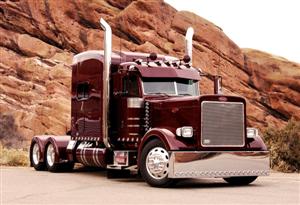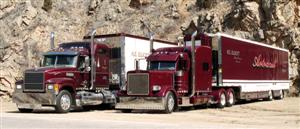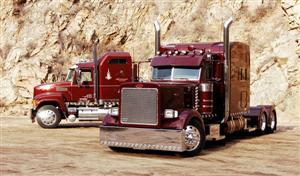THE ART OF HAULING ART
BY ROVING CORRESPONDENT TROY MILLER
When the terms “art” and “truck” are found together, most people begin to imagine a truck with detailed murals or intricate metal work. But for Howard Elliott of Denver, Colorado, art and trucks mean business. Howard, who runs a specialized trucking company called Artransit, hauls fine art, antiques and unique architectural pieces taken from old houses to be incorporated into new ones (he calls them architectural antiques). His freight, which is both delicate and high value, would leave most companies scratching their heads on how to load and transport what he moves everyday.
 Howard has been in the moving business for over 30 years, starting with lumping and loading jobs at several of the major moving lines in the 1980s when the Denver housing market (along with the rest of the country) was booming. When the oil companies started moving out of Denver, the housing market began to look more favorable in Denver to individuals and families from out of state – there was also a surplus of large, affordable houses available. A good portion of these people would move into Colorado without a permanent house yet, hiring Howard for their initial moves. After seeing his competence and skill, many of them rehired him to help them with their second move, into their new permanent home, once they bought it.
Howard has been in the moving business for over 30 years, starting with lumping and loading jobs at several of the major moving lines in the 1980s when the Denver housing market (along with the rest of the country) was booming. When the oil companies started moving out of Denver, the housing market began to look more favorable in Denver to individuals and families from out of state – there was also a surplus of large, affordable houses available. A good portion of these people would move into Colorado without a permanent house yet, hiring Howard for their initial moves. After seeing his competence and skill, many of them rehired him to help them with their second move, into their new permanent home, once they bought it.
Throughout this housing boom, Howard, who was using rented straight trucks, came to be one of the main shippers for an architectural antique auction house in San Francisco. He then came in contact with a gallery owner in Aspen, Colorado who happened to work with the San Francisco auction house. This connection allowed him to become the gallery owner’s main mover. From there, Artransit began hauling for more and more galleries, auction houses, museums, and art-owning individuals. Over the years, Howard has worked for over 30 museums, across the country, including the Museum of Contemporary Art in Denver and the Figge Art Museum in Davenport, Iowa, as well as many well-known celebrities such as Jimmy Fallon of Late Night, golfer Jack Nicklaus, jazz and pop singer Diana Krall, and musician Elvis Costello.
Around 2001, Howard realized that the small rented trucks he was using for the moves weren’t going to keep up with demand, so he decided that it was time to move up to a full-sized, over-the-road truck. Unfortunately, he had no idea of what to look for in a truck. This didn’t stop him, however, and later that same year he bought his first big rig truck – a plain white 1999 Mack CH – from his friend Donald Andre. Being new to trucking, he had to be taught how to double clutch the truck in a parking lot after he bought it so he could drive it home!
 After gaining enough experience to handle the truck on the road, he picked up his first load. Not wanting to have any major mishaps, he called a friend, Howard Peck, in Pennsylvania, and flew him out to help on the first trip. That first trip would be a memorable one, as he would have to maneuver that truck through downtown Chicago, Pittsburgh, Boston and Brooklyn, all on one trip. But, after surviving that inaugural run, he was ready to take his truck anywhere and everywhere.
After gaining enough experience to handle the truck on the road, he picked up his first load. Not wanting to have any major mishaps, he called a friend, Howard Peck, in Pennsylvania, and flew him out to help on the first trip. That first trip would be a memorable one, as he would have to maneuver that truck through downtown Chicago, Pittsburgh, Boston and Brooklyn, all on one trip. But, after surviving that inaugural run, he was ready to take his truck anywhere and everywhere.
After running the Mack for awhile, Howard decided to get more specialized equipment to better suit his business. Every load that Howard ships is different. There’s no set formula for how he can load a truck, and many times he plays the dual role of driver and handyman, as many of the antiques he hauls require disassembly for shipping. Aside from needing to know how and where to load the trucks, he also needs to understand aspects about the techniques and materials used to create the art or antiques themselves – each and every load can have different climate conditions in which it needs to be shipped to prevent tarnishing or other damage.
With so many responsibilities and obligations to consider, Howard chose to get a climate-controlled drop-deck van. He called Kentucky Trailers and was justifiably surprised when he found that a new trailer meeting his specs would cost about $120,000. Not wanting to go bankrupt, he began searching for a good used trailer. Eventually, he found a used 51-foot Kentucky trailer for half the price of a new one. Howard drove the Mack CH conventional, hooked to this Kentucky trailer, for several years.
 About the time his Mack was nearing the end of its useful life, Howard found himself driving past Colorado Mack and saw a shiny, maroon-colored Mack CH sitting on their lot. It was one of Mack’s new Rawhide Edition CH’s and it was beautiful. Howard walked in and told the salesman that he wanted to buy that truck. But, as it turned out, it was not just an ordinary Rawhide Mack – it was the first one built that Mack had taken across the country to display at various shows. Shortly thereafter, Howard had that first Rawhide hooked up to his Kentucky trailer.
About the time his Mack was nearing the end of its useful life, Howard found himself driving past Colorado Mack and saw a shiny, maroon-colored Mack CH sitting on their lot. It was one of Mack’s new Rawhide Edition CH’s and it was beautiful. Howard walked in and told the salesman that he wanted to buy that truck. But, as it turned out, it was not just an ordinary Rawhide Mack – it was the first one built that Mack had taken across the country to display at various shows. Shortly thereafter, Howard had that first Rawhide hooked up to his Kentucky trailer.
The 2004 Rawhide Mack, a model CHN613 with a 60-inch mid-rise sleeper, features many custom options straight from the factory. The truck has seven-inch dual turnout exhaust, a polished bumper and visor, double hump rear fenders and quad air-horns. Other features of the truck include bullet cab lights, cab and sleeper lights, a headache rack and full rear light bar. The interior of the Mack features a wood-grain dash and steering wheel, as well as chrome gauges. The truck is painted Wine Red Pearl, which, for some dumb reason, is a color that is no longer available due to DOT restrictions. All of this is backed by a 460 horsepower Mack engine, routed through an 18-speed transmission and 3.91 rears. In the midst of running the Rawhide Mack, Howard picked up a second 51-foot Kentucky trailer, but this one was a dry van with no climate control. So, it was now time to get a second truck.
Looking to pick up another big truck, Howard went to Rush Truck Center in Commerce City, Colorado, and ordered number thirteen of the last 1,000 Legacy Class 379 Peterbilt’s available. The 2007 truck is powered by a 2006 model Cat C-15 engine, with 625 horsepower, hooked to an 18-speed Eaton transmission and 3.72 rears. The truck came from the factory with seven-inch straight pipes, a 285-inch wheelbase, and paint that is a similar color to Howard’s Rawhide Mack. This truck would be Howard’s foray into building something cool and custom.
 After getting the new Legacy truck, Howard turned it over to Johnny Vonslochteren at Rush Truck Center, and the custom build process began. The truck now features stainless step boxes from the Chrome Shop Mafia, Valley Chrome bumpers (front and rear), an oval-punched grille, WTI double hump fenders in the rear and drop fenders in front, as well as a diamond-plate Merritt catwalk. Johnny also extended the sides of the hood to match the fenders and added cab and sleeper extensions to give the truck a lower look. An extensive amount of LED lights and 15-inch painted Donaldson air-cleaners complete the exterior.
After getting the new Legacy truck, Howard turned it over to Johnny Vonslochteren at Rush Truck Center, and the custom build process began. The truck now features stainless step boxes from the Chrome Shop Mafia, Valley Chrome bumpers (front and rear), an oval-punched grille, WTI double hump fenders in the rear and drop fenders in front, as well as a diamond-plate Merritt catwalk. Johnny also extended the sides of the hood to match the fenders and added cab and sleeper extensions to give the truck a lower look. An extensive amount of LED lights and 15-inch painted Donaldson air-cleaners complete the exterior.
With a uniquely-designed fleet to offer his customers more diversity, Howard also operates two smaller trucks – a two-tone blue Kenworth T300 and an International straight truck. The KW is used on smaller loads, while the International, a fairly stock unit, is used whenever he needs to pull into areas where a big truck and trailer may get damaged easily. Howard has been happily married for the past nine-and-a-half years to his wife, Liza, who also keeps the books and does the office management work for Howard’s company. With no kids, Howard keeps himself company out on the road with his five-month-old Sharpei puppy, Sadie.
Howard wanted to send special “thank yous” to his wife Liza for the joy of marriage and for helping with the books, Johnny Vonslochteren for helping build the 379, Colorado Mack and Denver Truck and Trailer for their help servicing the trucks and keeping them running, Donald Andre for selling him his first truck, and Howard Peck for helping him drive it on that fateful inaugural trip that started it all. Howard Elliott’s Artransit fleet of trucks not only hauls art, but they are rolling works of art themselves.
